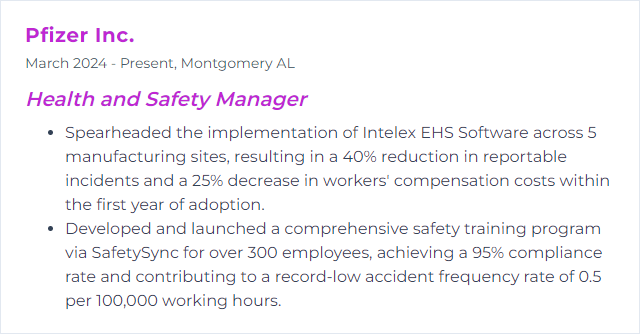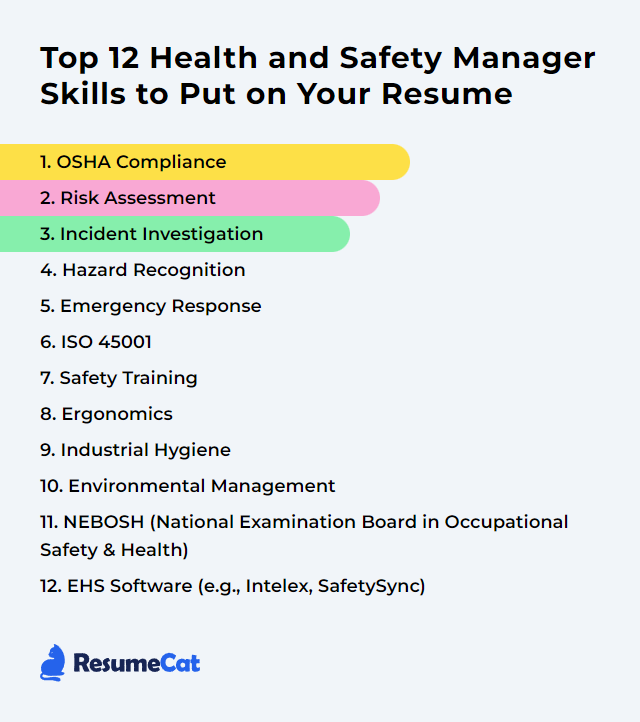Top 12 Health and Safety Manager Skills to Put on Your Resume
In today’s hiring climate, a standout Health and Safety Manager blends regulatory know‑how with real, lived safety culture. Not just checklists. Not just posters. The job demands sharp judgment, relentless follow‑through, and the ability to steer risk down before it swells. Put these skills on your resume and you don’t just look compliant—you look reliable under pressure.
Health and Safety Manager Skills
- OSHA Compliance
- Risk Assessment
- Incident Investigation
- Hazard Recognition
- Emergency Response
- ISO 45001
- Safety Training
- Ergonomics
- Industrial Hygiene
- Environmental Management
- NEBOSH (National Examination Board in Occupational Safety and Health)
- EHS Software (e.g., Intelex, Workhub)
1. OSHA Compliance
OSHA compliance means aligning your programs and day‑to‑day work with Occupational Safety and Health Administration standards. It’s policy, training, controls, documentation, and visible leadership that prevent injuries and illnesses—consistently.
Why It's Important
It keeps people safe, shields the organization from penalties, and builds trust that safety isn’t negotiable.
How to Improve OSHA Compliance Skills
Make it systematic. Then keep tuning it.
Conduct regular training: Tailor it to tasks, hazards, and literacy levels. Refresh often.
Perform risk assessments: Identify hazards, rate likelihood and severity, and apply layered controls.
Stay current: Track standard updates, interpretations, and enforcement trends. Update procedures fast.
Build a safety management system: Worker participation, hazard identification, control verification, and continuous improvement.
Keep clean records: Injury/illness logs, training, inspections, corrective actions—accurate and timely.
Audit proactively: Internal audits that test against regulatory requirements and your own procedures.
Engage employees: Simple reporting channels, no retaliation, rapid responses, public tracking of fixes.
Prepare for inspections: Clear roles, ready documentation, practiced site walks, disciplined follow‑up.
Do this well and violations shrink, culture improves, and operations run smoother.
How to Display OSHA Compliance Skills on Your Resume
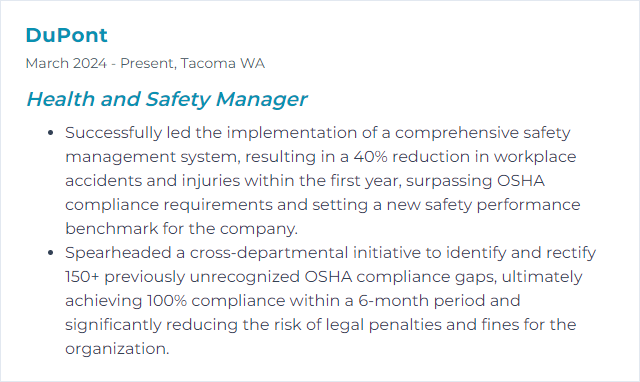
2. Risk Assessment
Risk assessment is the disciplined hunt for hazards, the evaluation of what could go wrong and how badly, and the choice of controls that actually hold up in the real world.
Why It's Important
It spotlights what matters most, reduces surprises, and anchors decisions to evidence—not guesswork.
How to Improve Risk Assessment Skills
Be methodical, be curious, be relentless.
Identify hazards: Observe work as done, review incidents and near misses, speak with workers, and scan change logs.
Analyze risk: Use a consistent matrix to rate likelihood and consequence. Validate ratings with data.
Apply the hierarchy of controls: Eliminate, substitute, engineer, administrate, and only then PPE—prefer permanence over persuasion.
Communicate clearly: Share risks and controls in plain language. Visuals help. So do toolbox talks.
Review often: New equipment, new chemicals, new layouts—reassess and adjust controls promptly.
Document decisively: Record assumptions, ratings, chosen controls, owners, and due dates.
When done right, risk assessment becomes a living process, not a dusty form.
How to Display Risk Assessment Skills on Your Resume
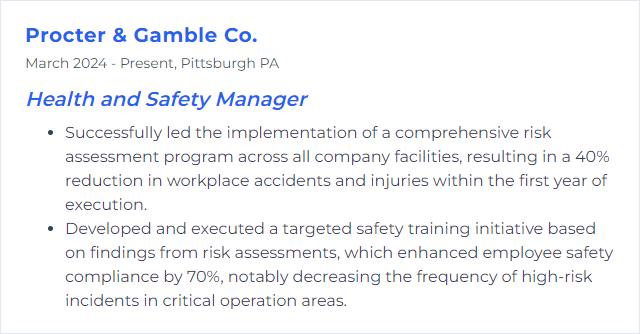
3. Incident Investigation
Incident investigation means digging past blame to find system causes—why defenses failed—and fixing them so the next time never happens.
Why It's Important
It prevents repeat events, strengthens compliance, and proves you value learning over finger‑pointing.
How to Improve Incident Investigation Skills
Structure first. Curiosity always.
Preparation: Standard forms, trained investigators, clear triggers for investigations, fast notification pathways.
Immediate response: Make the area safe, preserve evidence, get statements while memories are fresh.
Data collection: Photos, sketches, documents, procedures, training records, maintenance logs, shift patterns.
Analysis: Use techniques like Five Whys and fishbone diagrams. Consider human factors and work as actually performed.
Action plan: Corrective and preventive actions that address root causes, with owners and deadlines.
Follow‑up: Verify effectiveness. If controls don’t stick, escalate and redesign.
Share learning: Brief, anonymized lessons learned distributed quickly across the organization and tracked.
Leverage guidance from recognized bodies like ASSP and relevant standards to keep methods sharp and current.
How to Display Incident Investigation Skills on Your Resume
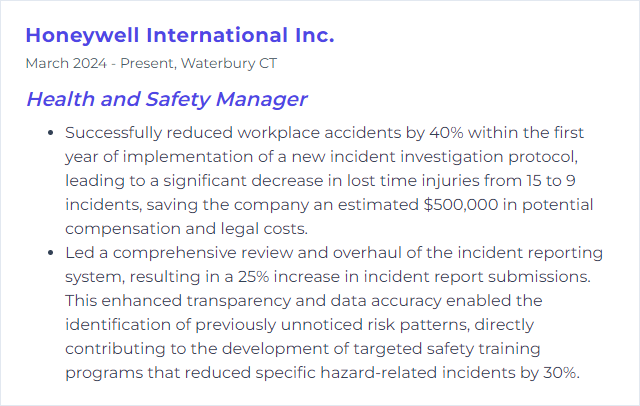
4. Hazard Recognition
Hazard recognition is the early‑warning radar—spotting physical, chemical, biological, ergonomic, and psychosocial risks before they bite.
Why It's Important
Because you can’t control what you don’t see. Early detection means cheaper, better fixes.
How to Improve Hazard Recognition Skills
Sharpen eyes. Widen lenses.
Targeted training: Teach what to look for, how to report, and why it matters. Refresh often and tailor by role.
Frequent walkarounds: Supervisors and workers scan together; mix scheduled and surprise tours.
Robust audits: Test barriers, not just check boxes. Verify controls in practice.
Frictionless reporting: Simple tools, anonymous options, fast feedback. Close the loop visibly.
Learn externally: Engage with professional organizations and safety communities to track emerging hazards and best practices.
Reinforce culture: Recognize good catches. Celebrate fixes. Make speaking up normal.
Over time, the whole workforce becomes your sensors.
How to Display Hazard Recognition Skills on Your Resume
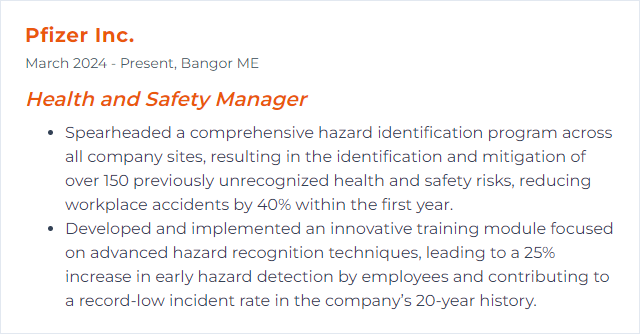
5. Emergency Response
Emergency response is the plan, practice, and muscle memory that turns chaos into coordinated action when fires, spills, medical events, severe weather, or security threats strike.
Why It's Important
Seconds matter. Good preparation saves lives, limits damage, and meets regulatory expectations.
How to Improve Emergency Response Skills
Prepare deeply. Drill realistically. Refine relentlessly.
Risk‑based planning: Identify credible scenarios and craft clear, role‑specific procedures for each.
Training and drills: Evacuations, shelter‑in‑place, spill response, first aid, AED use—practice until it’s automatic.
Communication: Redundant alerts and instructions (PA, text, email, radios). Keep contact lists current.
Equipment readiness: Extinguishers, eyewashes, spill kits, first aid supplies—inspected, accessible, and known to all.
Coordination: Align with local responders. Share site maps, hazards, and contact points.
Post‑event reviews: Hotwash after drills and incidents. Capture gaps. Fix fast. Retest.
Frameworks from agencies like FEMA, NFPA, and public health authorities offer solid benchmarks for quality.
How to Display Emergency Response Skills on Your Resume
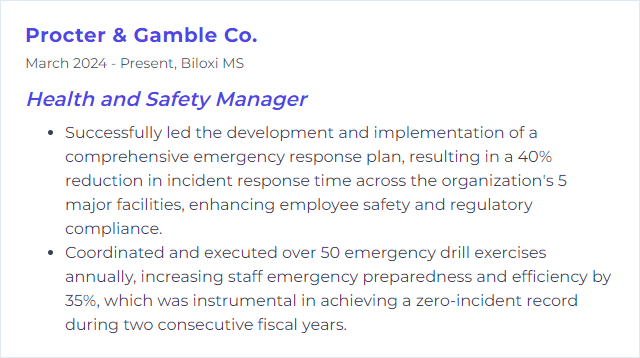
6. ISO 45001
ISO 45001 sets out what a robust occupational health and safety management system looks like—risk‑based, participative, and improvement‑driven.
Why It's Important
It brings structure and global credibility to your safety efforts, aligning leadership, worker input, and measurable outcomes.
How to Improve ISO 45001 Skills
Work the system, not just the certificate.
Gap analysis: Compare current practices to requirements. Prioritize fixes that reduce risk fastest.
Worker participation: Build consultation into procedures, controls, and change management.
Competence: Role‑specific training plans, verified skills, and refresher cycles.
Risk management: Proactive hazard identification, documented risk assessments, and verified controls.
KPIs: Leading and lagging indicators tied to objectives; review trends, not just snapshots.
Management review: Regular, evidence‑based, and action‑oriented. Assign owners. Track through closure.
Internal audits: Independent, risk‑focused, and candid. Findings feed improvement, not fear.
Incident learning: Root cause rigor and corrective actions that redesign systems, not just add PPE.
Legal compliance: Maintain a current legal register and verify conformance routinely.
PDCA mindset: Plan, do, check, act—on repeat. Small loops, quick wins, steady gains.
How to Display ISO 45001 Skills on Your Resume
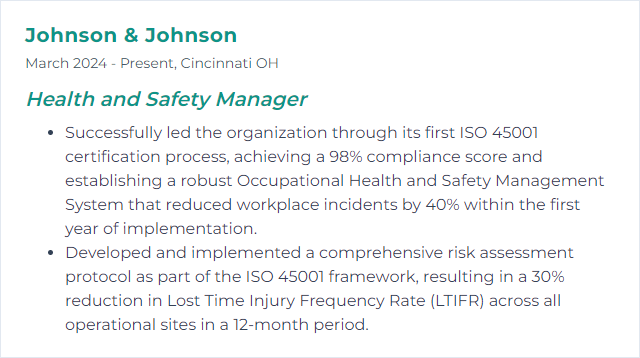
7. Safety Training
Safety training teaches people how to do risky work safely—and remember it when the pace quickens.
Why It's Important
Knowledge changes behavior. Behavior prevents harm. Compliance and productivity both climb.
How to Improve Safety Training Skills
Make it relevant. Make it sticky. Make it continuous.
Needs analysis: Map training to specific hazards, tasks, and incident trends. No generic fluff.
Blended learning: Mix instructor‑led, on‑the‑job, and digital micro‑learning to meet different styles and schedules.
Interactivity: Simulations, scenarios, quizzes, and hands‑on practice beat slides every time.
Keep it current: Update content with new equipment, procedures, and regulatory changes.
Measure impact: Pre/post checks, field observations, and behavior‑based verifications. Adjust fast.
Culture first: Reinforce in meetings, signage, and leadership walkarounds. Normalize speaking up.
Peer teaching: Experienced workers co‑train. Real stories land lessons.
Track completion and competence: Records that show who’s trained, qualified, and due for refreshers.
How to Display Safety Training Skills on Your Resume

8. Ergonomics
Ergonomics fits the job to the human—workstations, tools, and tasks that reduce strain and boost flow.
Why It's Important
Better comfort, fewer musculoskeletal disorders, stronger productivity. Less pain, more gain.
How to Improve Ergonomics Skills
Observe, adjust, and iterate.
Assess regularly: Use structured tools (e.g., RULA, REBA) and worker feedback to find stressors.
Train smart habits: Posture, lifting, micro‑breaks, and task rotation—simple steps with outsized payoff.
Engineer solutions: Adjustable chairs/desks, proper monitor heights, anti‑fatigue mats, ergonomic hand tools.
Program breaks: Short, scheduled pauses and task variety to cut static loads.
Encourage movement: Stretch guides and quick routines that fit the workday.
Follow up: Recheck after changes. Fine‑tune until discomfort data trends down.
How to Display Ergonomics Skills on Your Resume
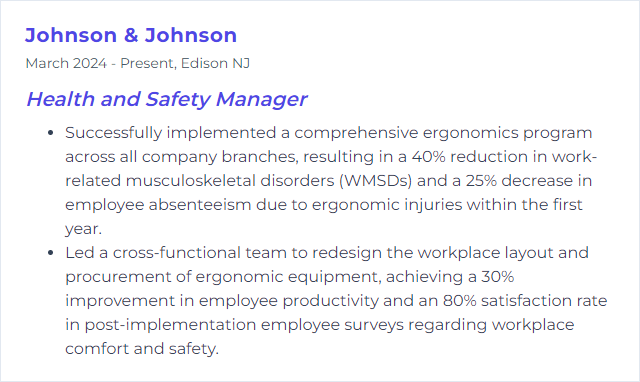
9. Industrial Hygiene
Industrial hygiene anticipates, recognizes, evaluates, and controls environmental factors—chemical, physical, biological—that can make workers sick.
Why It's Important
It suppresses exposures before they accumulate into disease, legal risk, or lost talent.
How to Improve Industrial Hygiene Skills
Chase exposure at the source.
Thorough assessments: Inventory hazards, tasks, and worker groups. Map exposure routes and durations.
Control strategy: Follow the hierarchy of controls, favoring elimination and substitution, then engineering.
Training and PPE: Teach proper use, limits, and maintenance. Fit testing where required.
Monitoring: Air and noise sampling, surface testing, and calibration routines. Compare to applicable limits.
Medical surveillance: Targeted programs for higher‑risk exposures with confidential follow‑up.
Records and trending: Exposure data, training, and health outcomes analyzed for patterns and hotspots.
Continuous improvement: Update procedures and controls as operations and science evolve.
How to Display Industrial Hygiene Skills on Your Resume
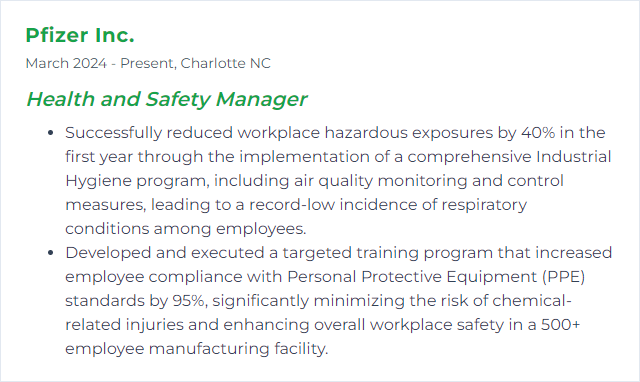
10. Environmental Management
Environmental management minimizes operational impacts on air, water, land, and communities—while staying square with the law and advancing sustainability.
Why It's Important
It protects health, preserves reputation, and cuts waste that drags on performance.
How to Improve Environmental Management Skills
Blend compliance with stewardship.
Know the rules: Track applicable environmental laws and permits. Keep a living register.
Audit routinely: Verify compliance and system effectiveness. Align with ISO 14001 practices where appropriate.
Reduce and reuse: Energy efficiency, water conservation, waste minimization, and responsible sourcing.
Train and engage: Make environmental roles clear. Set goals people can influence and celebrate progress.
Measure what matters: Use KPIs for emissions, waste, and resource use. Report trends and act on them.
Stakeholder dialogue: Communicate with communities, suppliers, and customers. Consider frameworks like GRI for transparency.
Plan for incidents: Maintain and drill environmental emergency plans to limit impacts fast.
How to Display Environmental Management Skills on Your Resume

11. NEBOSH (National Examination Board in Occupational Safety and Health)
NEBOSH provides globally recognized qualifications in health, safety, and environmental management. For managers, it signals depth—principles, practice, and the confidence to apply both.
Why It's Important
It validates competence across industries and jurisdictions, opening doors and standardizing language with peers and regulators.
How to Improve NEBOSH (National Examination Board in Occupational Safety and Health) Skills
Grow knowledge. Cement practice.
Commit to CPD: Webinars, workshops, and short courses that map to your gaps.
Use official materials: Study guides, examiner reports, and specifications to focus effort.
Apply on the job: Turn theory into procedures, inspections, and measurable outcomes.
Network: Engage with professional bodies and practitioner groups to swap tactics and insights.
Find a mentor: Experienced guidance sharpens judgment and accelerates growth.
Practice exams: Timed questions, model answers, and feedback loops improve performance.
Track legislation: Keep pace with regulatory changes relevant to your sector and region.
How to Display NEBOSH (National Examination Board in Occupational Safety and Health) Skills on Your Resume
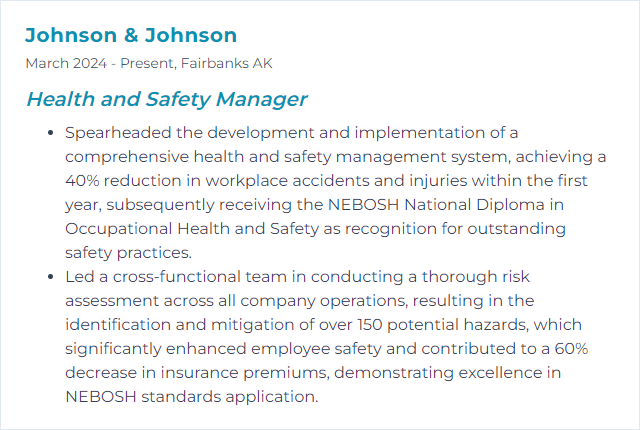
12. EHS Software (e.g., Intelex, Workhub)
EHS software centralizes compliance, incidents, audits, training, and analytics. It brings order, speed, and visibility to programs that sprawl.
Why It's Important
Better data, faster actions, clearer accountability. Trends appear sooner, and fixes land quicker.
How to Improve EHS Software (e.g., Intelex, Workhub) Skills
Design for the users, wire into operations, mine the data.
Upgrade UX: Intuitive navigation, mobile access, and role‑based dashboards so adoption sticks.
Integrate systems: Connect HR, maintenance, and operations platforms to cut duplicate entry and enrich insights.
Customize smartly: Tailor forms, workflows, and permissions to match your processes—without overcomplication.
Leverage analytics: Real‑time reporting, leading indicators, automated alerts, and scheduled reviews.
Train continuously: Onboarding for newcomers, refreshers for veterans, and quick reference guides.
Close the feedback loop: Collect user input, fix pain points, and communicate improvements.
How to Display EHS Software (e.g., Intelex, Workhub) Skills on Your Resume
